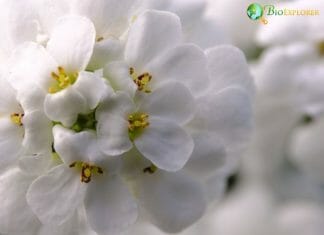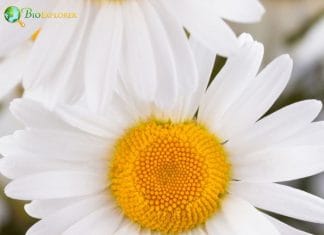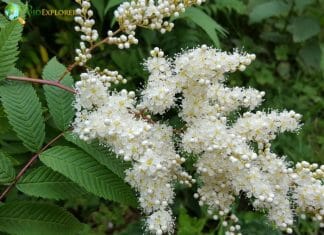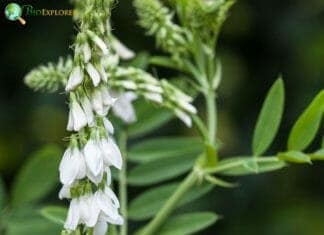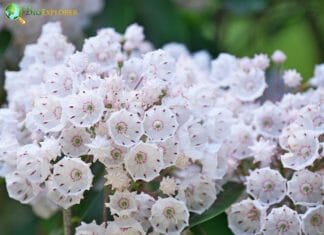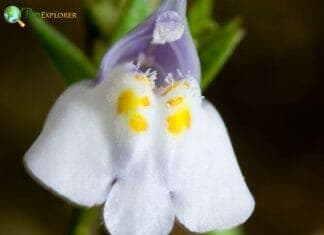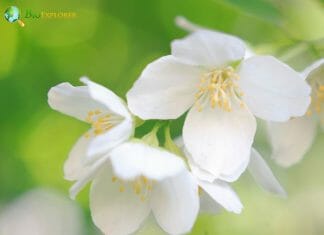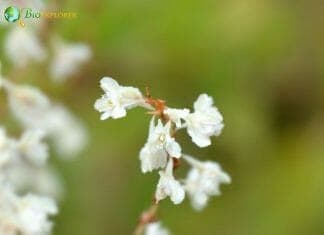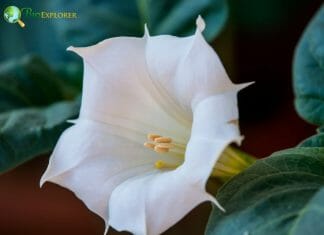
White flowers have long been cherished for their pristine beauty, delicate appearance, and the symbolic meanings they carry. From weddings to funerals, these elegant blooms are integral to many cultures and traditions worldwide. Beyond their aesthetic appeal, white flowers also hold significant scientific interest, with many species boasting unique botanical characteristics, ecological roles, and potential medicinal properties.
This comprehensive guide explores the top 85 white flowers, delving into their captivating features, rich symbolism, and fascinating fun facts. From the iconic Lily Of The Valley to the lesser-known Snowball viburnum, each flower has a story to tell. We’ll uncover the cultural significance behind favorites like gardenias and Jasmine and learn about the groundbreaking research surrounding camellias and Chrysanthemums.
Whether you’re a passionate gardener, a lover of floral aesthetics, or simply curious about the natural world, this in-depth article will provide you with a wealth of knowledge about these enchanting white blooms. So, let’s embark on a journey through the realm of white flowers and discover the secrets they hold.
Table of Contents
- Top White Flowers
- 1. Lily of the Valley
- 2. Gardenia
- 3. White Rose
- 4. Calla Lily
- 5. Daisy
- 6. Jasmine
- 7. White Tulip
- 8. Sweet Alyssum
- 9. Camellia
- 10. White Peony
- 11. White Hydrangea
- 12. Magnolia
- 13. Moonflower
- 14. Paperwhite Narcissus
- 15. Snowdrop
- 16. White Freesia
- 17. Anemone
- 18. Foxglove
- 19. White Chrysanthemum
- 20. Baby’s Breath
- 21. White Poppies
- 22. Queen Anne’s Lace
- 23. White Lilac
- 24. Snowball Viburnum
- 25. White Impatiens
- More White Blooms
- Candytuft
- Adam’s Needle
- Baneberry
- Buckbean
- Buddleia
- Casa Blanca
- Chamomile
- Convallaria
- Cowberry
- Dame’s Rocket
- Delphinium
- Dogwood
- Dutchman’s Breeches
- Edelweiss
- Elderflower
- Eupatorium
- False Spirea
- Feverfew
- Goat’s Beard
- Goat’s rue
- Holly
- Iberis amara
- Jamaica plum
- Japanese Canopy
- Japanese Iris
- Japanese Snake Gourd
- Japheth Orchid
- Jasmine
- Kalmia
- Lemon Blossom
- Mazus
- Meadowsweet
- Melaleuca
- Mock Orange
- Moonflower
- Nettle
- Nierembergia
- Nigella
- Night-flowering Catchfly
- Orange Blossom
- Ornithogalum
- Osteospermum
- Pearly Everlasting
- Pittosporum
- Polianthes tuberosa
- Pua Kala
- Privet
- Queens Cup
- Shasta Daisy
- Silver Lace Vine
- Snow in Summer
- Squirrel Corn
- Star Magnolia
- Starwort
- Stephanotis
- Sweet Woodruff
- Thornapple
- Trientalis
- Viburnum
- Wild Narcissus
- August Lily
- Conclusion
Top White Flowers
1. Lily of the Valley
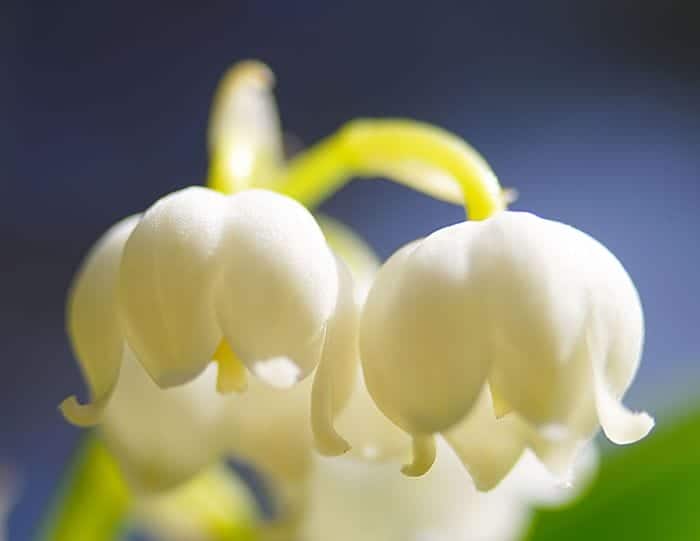
Lily of the Valley (Convallaria majalis) is a delicate and fragrant flowering plant that has captured the hearts of many with its sweet aroma and charming appearance. This perennial flower features dainty, bell-shaped white blossoms that hang gracefully from slender stems, surrounded by lush green foliage. Native to Europe and Asia, the lily of the valley has become a beloved symbol of spring, renewal, and the return of happiness.
In literature, the lily of the valley has been celebrated for its exquisite scent, often representing the essence of love. The flower’s fragrance is so unique that it has inspired perfumers to create complex fragrances that mimic its alluring aroma. However, despite its beauty, the lily of the valley is a flower of contrasts, as all parts of the plant are highly poisonous due to the presence of toxic compounds called cardiac glycosides.
Fun Facts:
- Balzac’s novel “The Lily of the Valley” is entirely built around the perception of the flower’s scent, highlighting its significance as a central symbol of love and identity.
- The challenge of capturing lily of the valley’s exact fragrance has led to the creation of innovative synthetic compounds, making it one of perfumery’s most significant odor families.
- Lily of the Valley contains over 30 cardioactive glycosides, emphasizing the striking contrast between its delicate appearance and its potent toxicity.
Suggested Reading:
Spider Lily
Flower Type: Perennials2. Gardenia

Gardenias are renowned for their lush, creamy white petals and intoxicating fragrances that can fill an entire room. These evergreen shrubs, native to tropical and subtropical regions, produce glossy green foliage that perfectly complements the stunning white blooms. Gardenias have long been admired for their beauty and have played significant roles in various cultures and traditions.
In Chinese culture, the gardenia flower has evolved from serving practical functions to holding deep symbolic meanings. Beyond representing purity and beauty, gardenias have come to symbolize a range of emotions and states, such as secret love, making them a versatile and meaningful presence in Chinese art and literature. The journey of this flower from a practical plant to a cultural emblem showcases the profound influence of nature on human society.
Fun Facts:
- Gardenias, particularly Gardenia Jasminoides, have been utilized in traditional medicine and as a natural colorant, contributing to the pharmaceutical, food, textile, and chemical industries.
- Recent research has focused on developing high-density genetic maps of gardenia to facilitate genome synteny and quantitative trait loci mapping for enhancing early growth and development traits in this valuable horticultural plant.
- The gardenia flower’s journey from practical use to a deep cultural symbol in China exemplifies the common trend of many flowers evolving to hold rich connotations and symbolic meanings in various traditions.
3. White Rose
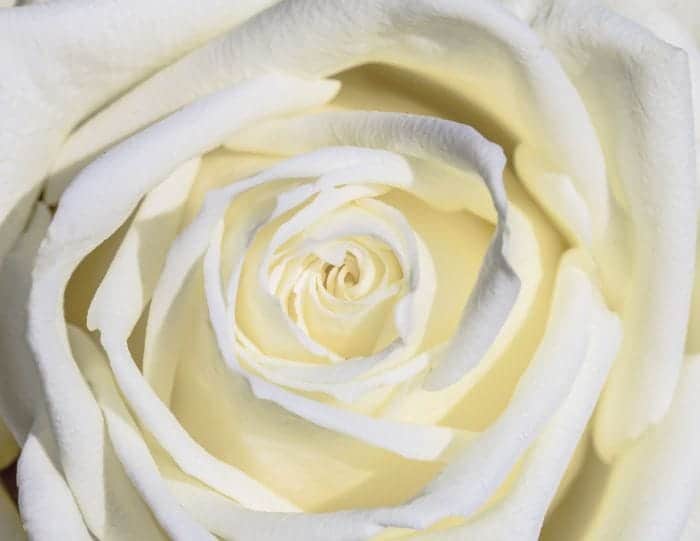
The white Rose is a timeless symbol of purity, innocence, and new beginnings. This classic flower has been cherished for centuries, captivating hearts with its simple elegance and graceful beauty. From bridal bouquets to memorial arrangements, the white rose has been a staple in many significant life events, representing the essence of love, respect, and remembrance.
In literature and art, the white rose has been used to convey complex emotions and ideals, often embodying themes of love, beauty, and perfection. The flower’s symbolic meaning extends beyond its physical appearance, as it has been associated with notions of secrecy and confidentiality, with the practice of hanging white roses in meeting rooms to ensure privacy.
Fun Facts:
- In ancient times, the white rose was associated with the goddesses of love. It was used to symbolize purity, secrecy, and innocence. It was customary to draw or hang a white rose in meeting rooms as a reminder to keep the information confidential.
- The white rose’s symbolic meaning extends beyond its physical beauty, representing themes such as love, beauty, grace, and perfection in literature and arts. Shakespeare frequently employed rose imagery, particularly the white rose, to convey complex human emotions and ideals.
- Studies have shown that extracts from white rose petals exhibit strong antimicrobial activities against certain Bacteria and Fungi and potent antioxidant properties, highlighting the flower’s potential as a natural source for developing antimicrobial and antioxidant agents.
4. Calla Lily

Calla Lilies are renowned for their stunning trumpet-shaped blooms and elegant, sculpted appearance. These flowers, native to southern Africa, come in various colors. Still, the pristine white variety is particularly cherished for its association with purity, rebirth, and transformation. The Calla Lily‘s graceful form has made it a popular choice for bridal bouquets, Easter celebrations, and funerals, where it symbolizes the transition of the soul and the beauty of life’s journey.
Despite its name, the calla lily is not a true lily but a member of the Araceae family. The flower’s unique structure, with its central spadix surrounded by a luminous spathe, has inspired artists and photographers for generations. Most notably, American artist Georgia O’Keeffe created a series of sensual and provocative calla lily paintings, cementing the flower’s status as an iconic subject in modern art.
Fun Facts:
- The calla lily is celebrated for its elegant, trumpet-shaped spathe, symbolizing beauty, purity, and rebirth. It is a popular choice in wedding bouquets and funeral arrangements, signifying the transition of the soul and the purity of love.
- American artist Georgia O’Keeffe created numerous provocative paintings of the calla lily, earning her the title “The Lady of the Lilies” and highlighting the flower’s enduring appeal as an artistic muse.
- Recent advancements in genetic research have provided insights into the calla lily’s flower spathe development, identifying genes and molecular markers that could enhance genetic diversity analysis and aid in breeding new cultivars with improved ornamental traits.
5. Daisy
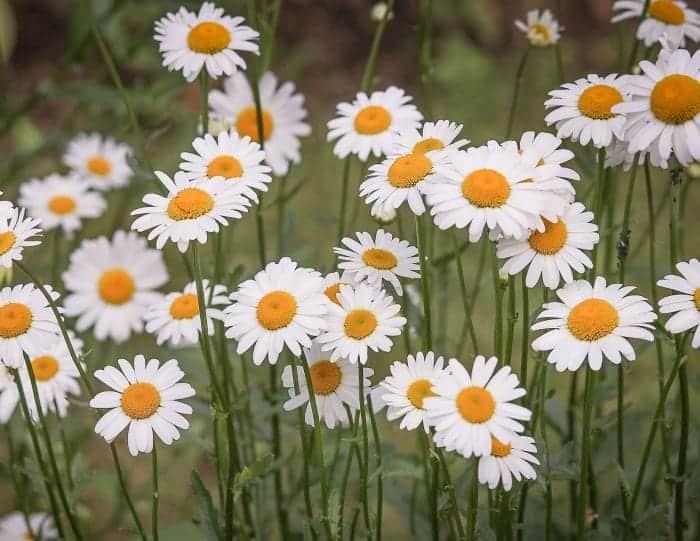
Daisies are one of the most recognizable and beloved flowers, known for their simple yet charming appearance. With their bright yellow centers surrounded by pristine white petals, these cheerful blooms symbolize innocence, purity, and new beginnings. The name “Daisy” derives from the Old English phrase “day’s eye, ” referring to the flower’s habit of opening its petals at dawn and closing them at dusk.
The daisy family, Asteraceae, is one of the largest and most diverse plant families, comprising over 23,000 species. From the tiny English daisy (Bellis perennis) to the impressive oxeye daisy (Leucanthemum vulgare), these flowers have adapted to various habitats across the globe. Beyond their ecological significance, daisies have also played a role in scientific research, with the hypothetical Daisyworld model demonstrating how organisms can influence their environment to maintain habitability.
Fun Facts:
- The English daisy (Bellis perennis) is widely recognized as a symbol of innocence, purity, and new beginnings due to its delicate appearance and the way it opens and closes its petals with the sun.
- The oxeye daisy (Leucanthemum vulgare), introduced to North America as an ornamental plant, has spread across the continent within two centuries, showcasing its resilience and adaptability.
- The Daisyworld model, proposed by James Lovelock, illustrates how organisms, represented by black and white daisies, can regulate their environment to maintain habitable conditions, supporting the Gaia hypothesis of Earth as a self-regulating system.
6. Jasmine

With its delicate Star-Shaped Flowers and heavenly fragrance, Jasmine has captured people’s hearts across cultures and continents. This evergreen shrub, belonging to the Oleaceae family, is native to tropical and subtropical regions of Asia, Africa, and Australia. Jasmine’s intoxicating scent and pure white blooms have made it a beloved choice for Gardens, perfumes, and tea flavoring.
Beyond its sensory appeal, Jasmine holds profound symbolic and cultural significance. Jasmine represents love, beauty, purity, and spiritual awakening in many traditions. Its fragrance is believed to have a calming and uplifting effect on the mind and soul, making it a popular choice for religious ceremonies and meditation practices. In literature and poetry, Jasmine often symbolizes romance, sensuality, and the ephemeral nature of life.
Fun Facts:
- In sand play therapy, Jasmine’s archetype encourages feminine healing qualities, helping individuals connect with the world through newfound life wisdom.
- Jasmine is revered in Javanese mysticism and Indian traditions for its ability to enhance physical and mental health, embodying the harmony between humans and their natural environment.
- In South Indian traditions, lactating women wear strings of jasmine flowers, believing that the fragrance can trigger neuroendocrine responses beneficial for lactation and prolonging amenorrhea, highlighting the flower’s association with femininity and nurturing.
7. White Tulip

White tulips are a symbol of forgiveness, purity, and new beginnings. These elegant flowers, with their smooth, pristine petals and graceful shape, have been cherished for centuries in gardens and floral arrangements worldwide. Native to Central Asia, tulips were introduced to Europe in the 16th century. They quickly became a sensation, leading to the famous “Tulipmania” in the Netherlands.
White tulips in the language of flowers carry a message of forgiveness and reconciliation, making them a popular choice for apologies and peace offerings. They are also associated with the idea of worthiness and heaven, conveying a sense of spiritual purity and divine love. In art and literature, white tulips often represent innocence, beauty, and the fleeting nature of life.
Fun Facts:
- White tulips are often associated with purity, forgiveness, and serenity. Their pristine appearance conveys a sense of peace and heavenly tranquility, making them a popular choice for expressing sincere apologies or creating an atmosphere of calm and reflection.
- Tulips, including white varieties, exhibit a wide range of genetic diversity, which is a focus of extensive research. Studies on tulips have aimed at understanding their genetic makeup to improve cultivation techniques, disease resistance, and floral characteristics.
- While scientific literature might not extensively cover the symbolic meanings of white tulips, their use in art, culture, and history is well-documented. Tulips have played a significant role in various cultures, from the Turkish and Persian empires to Dutch Tulipmania in the 17th century, symbolizing wealth, abundance, and indulgence.
8. Sweet Alyssum

Sweet Alyssum (Lobularia maritima) is a delightful, low-growing annual that produces clusters of tiny, fragrant white flowers. Native to the Mediterranean region, this versatile plant has become a favorite in gardens worldwide, thanks to its ability to thrive in various conditions and its long blooming period. Sweet alyssum’s dense, carpet-like growth habit makes it an excellent choice for Borders, rock gardens, and hanging baskets.
Beyond its ornamental value, sweet alyssum is crucial in ecosystem services. Its flowers attract beneficial insects such as hoverflies and parasitoid Wasps, which help control pest populations in gardens and agricultural settings. The plant’s ability to draw in these natural predators has made it a valuable tool in integrated pest management strategies, promoting sustainable and eco-friendly gardening practices.
Fun Facts:
- Sweet alyssum attracts beneficial insects, such as parasitoid wasps, which are crucial for agricultural biological pest control. These wasps have significantly longer lifespans when they access sweet alyssum flowers than when they are only provided with water.
- Research has shown that the volatiles from sweet alyssum flowers can repel Drosophila suzukii, a major pest of soft fruit Crops, suggesting that integrating this plant into crop fields could reduce pest infestation and minimize the reliance on chemical pesticides.
- The presence of sweet alyssum in agricultural fields has been associated with increased egg production of hoverflies, leading to a reduction in aphid populations, demonstrating the plant’s potential to enhance the effectiveness of biological control strategies in crop protection.
9. Camellia

Camellias are evergreen shrubs or small Trees that produce stunning, large flowers in white, pink, and red shades. Native to eastern and southern Asia, these Plants have been cultivated for centuries and prized for their beauty and economic importance. The genus Camellia comprises over 200 species, with many cultivars developed for ornamental and commercial purposes, such as producing tea, oil, and flowers.
White camellias, in particular, are associated with purity, perfection, and loveliness. In East Asian cultures, these flowers often symbolize the divine, the spiritual realm, and the beauty of nature. They are also connected to ideas of faithfulness, longevity, and the transience of life. In literature and art, white camellias have been used to represent both the innocence and the complexity of the human experience.
Fun Facts:
- Camellia is an economically significant genus due to its popular commercial products, such as tea leaves, ornamental flowers, and high-quality edible oils, representing the largest and most crucial genus in the Theaceae family.
- Research on cold acclimation in Camellia japonica has uncovered that α-linolenic acid and jasmonic acid biosynthesis pathways respond to cold acclimation, providing insights into the genetic and molecular basis of responses to cold stress in Camellia plants.
- The study of chloroplast genomes in Camellia species has clarified phylogenetic relationships within the genus, supporting the use of chloroplast genome data for resolving species definition and interspecies relationships in Camellia.
10. White Peony

White peonies are luxurious, full-bodied flowers that have captivated gardeners and enthusiasts for centuries. These perennials, native to Asia, Europe, and Western North America, are known for their large, fragrant blooms and lush foliage. In various cultures, white peonies symbolize wealth, prosperity, and good fortune, making them popular for weddings and other celebratory occasions.
Beyond their ornamental value, white peonies have been used in traditional medicine for their therapeutic properties. The plant’s roots, bark, and flowers contain compounds that have been studied for their potential anti-inflammatory, antioxidant, and anti-tumor effects. In recent years, scientific research has focused on identifying and isolating the bioactive compounds in white peonies to develop new pharmaceutical and nutraceutical products.
Fun Facts:
- White Peony, a type of white tea derived from Camellia sinensis, is rich in polyphenols that exhibit strong free radical scavenging capabilities, effectively reducing liver indices in mice with alcohol-induced liver injury, suggesting their potential as high-quality natural products with protective effects against liver damage.
- The aesthetic beauty of the peony, including its symbolism of wealth and prosperity, has inspired knit fashion design, with designers creating unique pieces that incorporate the flower’s voluminous and fancy attributes, showcasing the peony’s influence beyond traditional gardens and into the realm of high fashion.
- Studies on the genetic basis of flowering time and floral organ development in tree peonies have identified several critical genes, providing valuable insights into the molecular mechanisms regulating these processes and offering new avenues for breeding and genetic research aimed at enhancing the ornamental value of peonies, such as developing cultivars with varied and extended blooming periods.
11. White Hydrangea
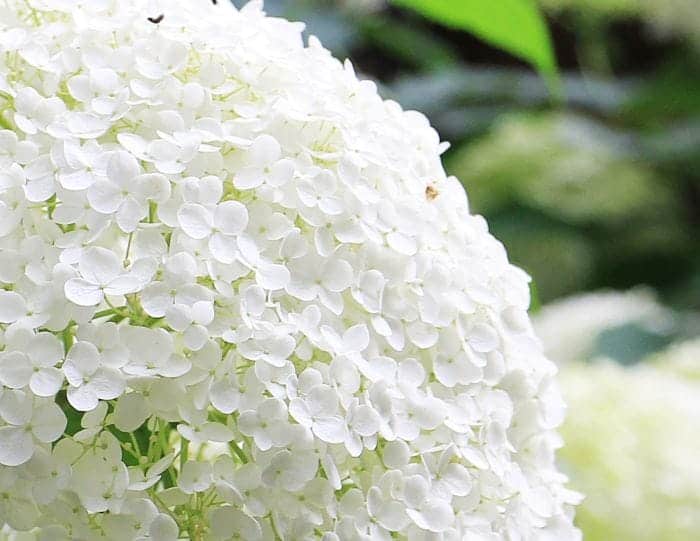
White hydrangeas are beloved for their large, showy blooms that grace gardens and floral arrangements during summer. These deciduous shrubs, native to Asia and the Americas, produce spherical or conical clusters of small, star-shaped flowers measuring up to 12 inches in diameter. The flowers are surrounded by larger, more ornamental sepals that give the inflorescence its distinctive appearance.
White hydrangeas symbolize purity, grace, and abundance in the language of flowers. They are often associated with gratitude, understanding, and heartfelt emotions. In some cultures, white hydrangeas are given as gifts to express apology or convey unity and togetherness. These plants’ delicate beauty and generous blooms have made them a favorite among gardeners and floral enthusiasts worldwide.
Fun Facts:
- Hydrangeas show significant genome size variation among different species and subspecies, which is related to their chromosome numbers and has implications for phylogenetic relationships, the origin of chromosome number, and genetic diversity within the genus. The smallest genome sizes were found in North or South American species.
- Despite its beauty, the garden Hydrangea is susceptible to foliar diseases, such as a specific leaf spot disease caused by Myrothecium roridum, which can impact its appearance, health, and market value, highlighting the importance of monitoring and managing plant health to maintain the aesthetic and commercial value of hydrangeas.
- Hydrangeas exhibit a wide range of flower morphologies, from the Hydrangea floral syndrome characterized by small size and tetramerous-pentamerous perianths to species with polystemony and synstyly. This diversity is not only aesthetically significant but also provides insights into the Hydrangeaceae family’s phylogenetic relationships and evolutionary history.
12. Magnolia

Magnolias are ancient flowering plants that have captivated humans for centuries with their stunning blooms and graceful beauty. These deciduous or evergreen trees and shrubs are native to Asia and the Americas, boasting large, fragrant white, pink, and Purple Flowers. Magnolia comprises over 200 species, many prized for their ornamental value, and have been cultivated in gardens worldwide.
White magnolias, in particular, are associated with purity, nobility, and perseverance. In Chinese culture, the magnolia flower symbolizes feminine beauty, gentleness, and the embodiment of yin Energy. The blooms are also connected to ideas of enduring love, fidelity, and the transience of life. In traditional medicine, various parts of the magnolia plant have been used to treat a range of ailments, from anxiety and depression to inflammation and cancer.
Fun Facts:
- Magnolia flowers are protogynous and are known to be pollinated by several species of beetles, which enter the buds as well as closed and open flowers to feed on nectar, stigmas, pollen, and secretions of the petals, highlighting a special evolutionary adaptation of magnolias.
- Magnoliales, including magnolias, were once considered among the most archaic orders of flowering plants. However, molecular analyses have placed them among other eumagnoliids. Studies on Magnoliales and Myristicaceae have implications for character Evolution within the group, providing insights into the evolutionary history of magnolias and related families.
- Magnolia species, including their bark and seed cones, have been used in traditional herbal medicines across Korea, China, and Japan for various diseases, from headaches to cancer. Recent research has highlighted their anti-cancer, anti-stress, anti-anxiety, anti-depressant, antioxidant, anti-inflammatory, and hepatoprotective effects, demonstrating the significant medicinal value of magnolia species.
13. Moonflower

Moonflowers are enchanting, night-blooming vines belonging to the genus Ipomoea, including morning glories. These annual climbers, native to tropical and subtropical regions of the Americas, are known for their large, fragrant, white flowers that unfurl at dusk and close with the morning light. The ethereal beauty of moonflowers has captured the imagination of gardeners, artists, and writers for generations.
In folklore and mythology, moonflowers are often associated with mystery, magic, and the realm of dreams. Their nocturnal blooming habit and luminous white petals have led to their connection with the moon, feminine energy, and the subconscious mind. In literature, moonflowers have been used as symbols of transformation, intuition, and the journey towards self-discovery.
Fun Facts:
- The Moonflower (Ipomoea turbinata) is characterized by its impressive vegetative growth and seed maturation. A typical plant can produce numerous runners with a total length of 185 m, about 1,120 leaves, and an average of 9,350 seeds per plant. The seeds have a dormancy mechanism due to their coats’ impermeability.
- Moonflowers have been a subject in literature, reflecting themes of mysticism and the inner journey toward mystical union. Victorian fairy tales, such as Laurence Housman’s The Moon-Flower (1895), utilize moonflower symbolism to depict the main characters’ transformative journey, blending fairy tales and religious traditions to tell stories of inner transformation.
- Robert J. Turney’s moonflower photographic studies represent an exploration over three years of summer evenings, capturing the flowers in various stages of blossoming and highlighting their beauty in darkness. These photographs are a testament to the aesthetic appeal and uniqueness of the moonflower.
14. Paperwhite Narcissus

Paperwhite Narcissus (Narcissus papyraceus) is a fragrant, winter-blooming bulbous plant that belongs to the Amaryllidaceae family. Native to the Mediterranean region, these elegant flowers are known for their pure white, star-shaped blooms that grow in clusters atop slender, green stems. Paperwhites are often forced indoors during winter, providing a welcome splash of color and a delightful scent to homes and gardens.
In the language of flowers, paperwhite narcissus symbolizes hope, renewal, and the promise of spring. The flower’s ability to bloom during the coldest months of the year has made it a popular choice for holiday decorations and a gift to brighten someone’s day. In Greek mythology, the narcissus flower is associated with the tale of Narcissus, a young man who fell in love with his own reflection and was transformed into a flower to punish his vanity.
Fun Facts:
- Paperwhite narcissus, particularly the Tazetta group, is a significant flower crop in Israel, with over 20 million bulbs exported annually. New cultivars like ‘Ariel’ and ‘Inbal’ have been developed to extend the blooming period beyond the typical December to January timeframe, demonstrating advancements in controlling the flowering process of these plants.
- Research has identified potyvirus species associated with yellow leaf stripe disease in paperwhite narcissus, which is crucial for understanding the diseases that affect narcissus crops and for developing strategies to mitigate these issues, ensuring these flowers’ healthy growth and commercial viability.
- Ethanol has been shown to effectively reduce unwanted floral scape and leaf elongation in ‘Ziva’ paperwhite narcissus when grown in traditional pebble culture, providing a safe and organic method for controlling the height of this popular flowering bulb and allowing for more aesthetically pleasing arrangements and displays.
Suggested Reading:
December Birth Flowers
15. Snowdrop
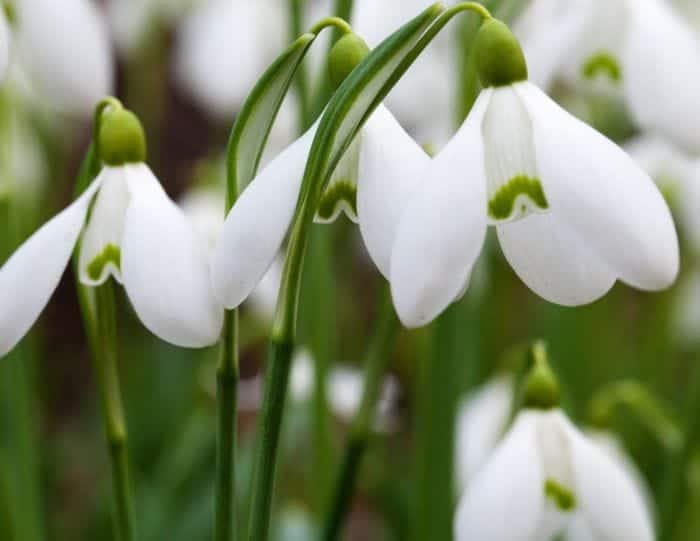
Snowdrops (Galanthus spp. ) are delicate, early-spring flowering bulbs that have long been admired for their resilience and beauty. These small, white flowers are among the first to emerge from the frozen ground, often pushing through snow and ice to herald the coming of spring. Native to Europe and the Middle East, snowdrops have naturalized in many parts of the world and have become a beloved symbol of hope and renewal.
In folklore and mythology, snowdrops are associated with purity, innocence, and the promise of new beginnings. They are also connected to themes of consolation, sympathy, and the ability to overcome hardship. In some cultures, snowdrops symbolize death and remembrance, as they often bloom in graveyards and are used in funeral arrangements.
Fun Facts:
- Snowdrops are valued for their ornamental appeal as early spring flowers and have significant scientific and commercial interest due to galanthamine, a compound used for the symptomatic treatment of Alzheimer’s disease, making them exciting sources for drug discovery and nutraceutical development.
- Snowdrops possess a unique thermogenesis ability, allowing them to melt the snow and emerge as early signs of spring. The flower has been associated with various myths and folklore, symbolizing hope and the triumph of spring over winter. In the 16th century, snowdrops were considered medicinal and were later used to treat polio in Bulgaria.
- In Turkey, the snowdrop (Galanthus elwesii) is valued for its larger flowers and firmer bulbs, which make it preferred by Western European growers. For sustainable production and to prevent the reduction of wild snowdrop populations, bulbs should be removed and replanted every 3-4 years to maintain health and size for domestic and international trading.
16. White Freesia

White freesias are elegant, Fragrant Flowers that belong to the Iridaceae family. Native to South Africa, these herbaceous perennial plants produce delicate, funnel-shaped blooms that grow along one side of a curved spike. The pure white petals of freesias are often tinged with yellow or green at the center, adding a subtle touch of color to the flower’s pristine appearance.
In the language of flowers, white freesias symbolize innocence, purity, and friendship. They are often given as gifts to express trust, thoughtfulness, and the desire for a strong, lasting connection. The sweet, captivating fragrance of white freesias has made them a popular choice for bridal bouquets, as well as in perfumes and aromatherapy.
Fun Facts:
- White freesia (Freesia refracta alba) is admired for its symbolic significance of early spring. Efforts in Japan have aimed at extending the flowering time for year-end production, showing the commercial and horticultural value of white freesia beyond its traditional blooming season. Research on cool storage of corms has been crucial for advancing flowering time and achieving year-round production.
- The sweet fragrance of white freesia is composed of diverse volatile organic compounds, including monoterpenesWhat is monoterpenes?Monoterpenes are a class of naturally occurring organic compounds found in plants, characterized by their fragrant aromas and typically composed of two isoprene units. such as linaloolWhat is linalool?Linalool is a naturally occurring terpene alcohol found in many flowers and spice plants, known for its pleasant floral aroma and widely used in perfumes, cosmetics, and flavorings. and D-limoneneWhat is D-limonene?D-limonene is a naturally occurring terpene found in the peels of citrus fruits, prized for its citrus aroma and utilized in various industrial and household applications, including cleaning products, fragrances, and as a natural solvent., which are key to its pleasant aroma, making it a popular choice for perfumes and aromatic products.
- Freesia, including the white varieties, has been subject to extensive breeding and selection, leading to a wide range of cultivars with varying colors, sizes, and scents. Modern breeding techniques have focused on developing cultivars that exhibit high decorative qualities, increased disease resistance, and adaptability to various growing conditions, highlighting the ongoing interest in enhancing the ornamental value of freesia.
17. Anemone
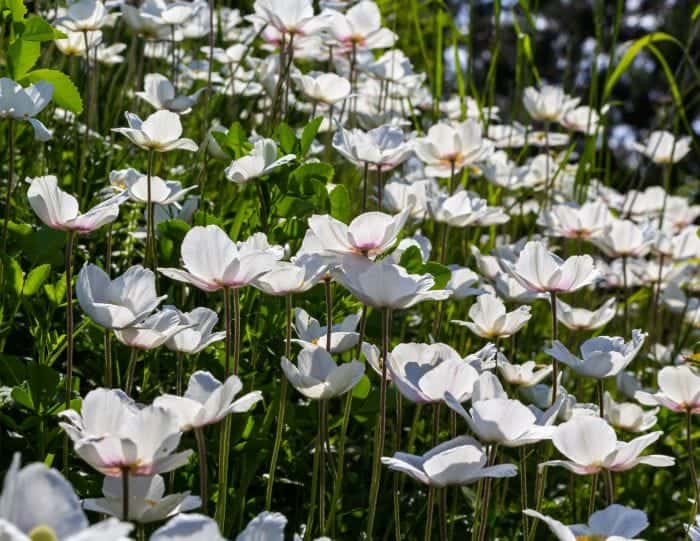
Anemones are enchanting flowers belonging to the Ranunculaceae family, with over 150 species found in a wide range of habitats worldwide. Also known as windflowers, these delicate blooms are named after the Greek word “anemos“, meaning wind, as they are said to open when the wind blows. White anemones, in particular, are associated with purity, sincerity, and the anticipation of something new.
In Greek mythology, anemones are linked to the tragic love story of Adonis and Aphrodite. According to legend, anemones sprung from the tears of Aphrodite as she mourned the death of her beloved Adonis. This tale has led to the flower’s association with forsaken love and the transience of life. In other cultural contexts, anemones have been used to symbolize anticipation, good luck, and protection against evil.
Fun Facts:
- Anemone, a genus with over 150 species, has been used in folk and worldwide ethnomedicine. It’s a rich source of triterpenoid saponins, with some compounds showing anti-cancer activities. Anemone compounds exhibit a range of bioactivities, including immunomodulatory, anti-inflammatory, antioxidant, and antimicrobial effects. The ethnopharmacological uses of more than 50 Anemone species provide clues for modern drug discovery.
- The genome of the starlet sea anemone (Nematostella vectensis) reveals the complexity of the eumetazoan ancestor’s genome, with gene repertoire and genomic organization more similar to vertebrates than to flies or nematodes. This suggests that the ancestor of eumetazoans had a complex genome, which has implications for understanding the evolutionary history of animals.
- In the tripartite symbiosis involving anemonefish, host anemone Heteractis crispa, and zooxanthellae, there is direct evidence for the transfer of nutrients from host anemone and zooxanthellae to anemonefish. This “translocation” and resultant recycling of elements highlight the essential role of nutrient dynamics in this symbiotic relationship, suggesting a fundamental mutual benefit among the participants.
18. Foxglove

Foxgloves (Digitalis spp. ) are striking, Bell-Shaped Flowers that have captured the imagination of gardeners, artists, and writers for centuries. These biennial or short-lived perennial plants are native to Europe, western Asia, and northwestern Africa. They are known for their tall, elegant spikes adorned with white, pink, purple, or yellow blooms. The common name “foxglove” is believed to derive from the Old English words “folk” (meaning folk or fairy) and “gliew” (meaning music), referring to the flower’s association with magic and folklore.
Despite their beauty, foxgloves are highly poisonous plants due to the presence of cardiac glycosides, which can cause severe heart problems if ingested. Ironically, this toxicity has also led to the development of important heart medications, such as digoxin, which are derived from foxglove compounds. In the language of flowers, foxgloves symbolize insincerity, intuition, creativity, and the healing power of nature.
Fun Facts:
- The foxglove plant, Digitalis Purpurea, has a long history of medical use, highlighted by William Withering’s 1785 report, “An Account of the Foxglove and Some of Its Medical Uses: With Practical Remarks on Dropsy and Other Diseases. ” This work established the use of foxglove extracts for treating heart conditions, notably dropsy, which we now understand as heart failure, laying the groundwork for modern pharmacologyWhat is pharmacology?Pharmacology is the science of drugs and their effects on living systems, exploring how medications work and are used to treat diseases..
- The primary medicinal compounds extracted from foxglove are cardiac glycosides, such as digoxin and lanatoside C. These compounds are crucial for treating heart disorders because they increase the force of heart muscle contractions and are used in managing conditions like atrial fibrillation and heart failure. Recent advancements in biotechnology have focused on optimizing the in vitro production of these vital compounds.
- Despite its therapeutic benefits, foxglove leaves contain toxic cardiac glycosides and can cause poisoning if ingested incorrectly. There have been instances of accidental poisoning due to the leaves being confused with other herbs, underscoring the dangers of herbal medicine when plant identification mistakes occur and the fine line between a medicine and a poison.
19. White Chrysanthemum

White chrysanthemums are stunning, star-shaped flowers that belong to the Asteraceae family. These perennial plants, native to East Asia and northeastern Europe, have been cultivated for centuries for their ornamental beauty and cultural significance. In many Asian countries, particularly China and Japan, white chrysanthemums are associated with Honesty, loyalty, and devoted love. They are often used in funeral arrangements to symbolize grief, mourning, and the desire for a peaceful afterlife.
Beyond their symbolic meaning, white chrysanthemums have also been the subject of scientific research. Studies have focused on the flower’s unique biochemical properties, genetic diversity, and potential applications in developing new cultivars. The intricate structure and pristine white color of chrysanthemum blooms have also inspired artists and designers across various mediums.
Fun Facts:
- The three-dimensional fluorescence technique has been used to discriminate among species of white chrysanthemum flowers, revealing remarkable differences in fluorescence intensity related to flavonoidsWhat is flavonoids?Flavonoids are a diverse group of plant secondary metabolites known for their antioxidant properties and health benefits. They are commonly found in fruits, vegetables, tea, wine, and other plant-based foods, contributing to their vibrant colors and potential health-promoting effects. and chlorophyll-like compounds. This approach indicates the potential of using fluorescence spectra for low-cost, easy operation and intuitive discrimination among white chrysanthemum species, showcasing their unique biochemical signatures.
- In white chrysanthemum petals, the presence of a gene, CmCCD4aWhat is CmCCD4a?CmCCD4a, a member of the carotenoid cleavage dioxygenase (CCD) gene family, plays a crucial role in regulating plant growth and development through its involvement in the biosynthesis of plant hormones., which inhibits the accumulation of carotenoids, leads to their white color. The high expression levels of CmCCD4a in white-flowered cultivars result in the degradation of carotenoids into colorless compounds, shedding light on the genetic basis of petal color in chrysanthemums and suggesting a path for creating flowers with novel colors through genetic manipulation.
- The nutritional status, particularly nitrogen, phosphorus, and potassium levels, significantly influence the floral characteristics of the chrysanthemum, including flower size, color, and bloom duration. This highlights the importance of optimized nutrient management for achieving desired ornamental traits in chrysanthemum cultivation, supporting the potential for targeted nutrient applications to enhance white chrysanthemums’ beauty and commercial value.
20. Baby’s Breath

Baby’s Breath (Gypsophila spp. ) is a delicate, airy flower that has become a staple in floral arrangements worldwide. These small, white, or pink blooms grow in clusters on slender, branching stems, creating a soft, cloud-like appearance. Native to Europe, Asia, and northern Africa, baby’s breath has been cultivated for centuries for its ornamental value and symbolic meaning. In the language of flowers, baby’s breath represents innocence, purity, and Everlasting love, making it a popular choice for weddings and other romantic occasions.
Despite its delicate appearance, baby’s breath is a hardy plant that can thrive in various climates and soil conditions. In some regions, particularly in North America, certain species of baby’s breath have become invasive, forming dense stands that can outcompete native flora. This has led to increased research on the plant’s ecological impact and the developing of management strategies to control its spread.
Fun Facts:
- Gypsophila paniculata (baby’s breath) was introduced to North America in the late 1800s as a garden ornamental and horticultural crop. It quickly spread, often forming dense monotypic stands and crowding out native species. Genetic analyses of samples from various U. S. locations revealed at least two genetic clusters, suggesting at least two invasion events.
- Research has shown that using organic compounds such as Bovine Manure and Humoativo can significantly enhance the morphological characteristics of a baby’s breath, including plant height, number of flower stems, and flower diameter. This demonstrates the potential for using organic Fertilizers to improve the growth and ornamental qualities of Gypsophila paniculata, highlighting the importance of sustainable agricultural practices in floriculture.
- A novel double-flowered cultivar of Gypsophila paniculata, named ‘Huixing 1’, was developed through gamma radiation mutagenesis. This new cultivar, derived from the ‘Cloudstar 4’ variety, features bigger flowers with more petals than its predecessor. This advancement in floriculture demonstrates the potential of radiation mutagenesis to create new plant varieties with desirable ornamental traits.
21. White Poppies

White poppies are striking flowers that belong to the Papaveraceae family. These annuals or short-lived perennials are known for their delicate, papery petals and a central crown of yellow stamens. While red poppies are often associated with remembrance and sacrifice, white poppies have come to symbolize peace, hope, and the end of war. White poppies are also linked to sleep, dreaming, and eternal life in some cultures.
Poppies have a long and fascinating history, with evidence of their cultivation dating back to ancient civilizations. They have been used for medicinal and culinary purposes and for their ornamental beauty. The genus Papaver, to which white poppies belong, is also known for producing opium and other alkaloids, which have played a significant role in human history and culture.
Fun Facts:
- Poppies have been utilized since antiquity as a source of food, therapeutics, and poisons. The Neolithic age likely saw the alimentary value of Poppy seeds, and evidence suggests that the neuropsychopharmacological effects of poppy juice were exploited during the Minoan civilization. Poppies have been connected to agricultural fertility rites and attributed symbolic meanings related to fertility and goddesses like Demeter, Aphrodite, and Ceres in various ancient cultures.
- Beyond fertility, poppies symbolize sleep, night, and death, aligning with the agrarian origin of their ritual use. They also represent reincarnation, evidenced by literary and iconographic sources, particularly from the early Roman imperial age, suggesting that poppy derivatives were ingested during mystery rites. The reversible narcotic effects of poppy derivatives were likely used for a realistic representation of death and reincarnation, resonating with Orphic beliefs in the transmigration of souls.
- The imagery of tall poppies is a metaphor used in Australian discourse to describe individuals brought down due to their high achievements or self-adulation. This metaphor reflects broader cultural values about equality and rejecting undue superiority. While the tall poppy syndrome scrutinizes high achievers, it is also a cultural reflection on the balance between individual achievement and collective societal values.
22. Queen Anne’s Lace

Queen Anne’s Lace (Daucus carota) is a delicate, lacy wildflower from the Apiaceae family. Also known as wild carrot, this biennial plant is native to Europe and Asia but has naturalized in many parts of North America. The flower heads are composed of numerous tiny, white florets arranged in a flat-topped umbel, with a single, dark purple or red floret often found at the center. This central floret represents a drop of blood where Queen Anne pricked her finger while making lace, giving the plant its common name.
Queen Anne’s Lace symbolizes sanctuary, complexity, and delicacy in the language of flowers. The intricate, lace-like appearance of the flower heads has inspired artists, designers, and writers for centuries. Despite its beauty, Queen Anne’s Lace is considered a noxious weed in some areas due to its ability to invade agricultural fields and outcompete native species.
Fun Facts:
- The dark central florets of Queen Anne’s Lace influence insect visitation and fruit production. A study conducted across five locations in the eastern United States found that removing these central florets did not significantly affect fruit production despite varying levels of insect attraction, suggesting that while the central florets may attract certain insects, they do not universally increase fruit production unless the attracted insects are common or very effective pollinators.
- An aster yellows phytoplasma was detected in Queen Anne’s lace plants in Alberta, Canada, presenting typical symptoms such as yellowing and stunted growth. This finding underscores the susceptibility of Queen Anne’s lace to plant diseases and the importance of monitoring these conditions for maintaining healthy populations.
- Queen Anne’s lace has a rich cultural and historical background, including its association with Saint Anne in late medieval society. The intricate patterns of its flowers have symbolized sanctuary and complexity, reflecting the societal and religious values of the time.
23. White Lilac

White lilacs (Syringa Vulgaris) are fragrant, deciduous shrubs that belong to the Oleaceae family. These stunning flowers are native to the Balkan Peninsula but have been widely cultivated throughout Europe and North America for their ornamental value and intoxicating scent. The small, four-lobed flowers grow in dense, conical panicles and bloom in late spring, filling the air with their sweet perfume.
In the language of flowers, white lilacs symbolize purity, innocence, and the beauty of youth. They are often associated with new beginnings, renewal, and the promise of spring. In some cultures, white lilacs are also linked to memories, nostalgia, and the bittersweet nature of fleeting moments.
Fun Facts:
- White lilac is celebrated for its ornamental properties, including graceful postures and dense flowers and leaves. Beyond its beauty, lilac also plays significant ecological roles, showcasing strong resistance and high adaptability. The plant’s botanical characteristics and ecological traits make it a favored choice for landscape greenery, offering both aesthetic value and environmental benefits.
- Research into the development of flower organs in common lilac (Syringa vulgaris) has provided detailed insights into the flowering process. The study observed the development of flower organs through various stages, revealing the intricate processes that lead to the blooming of lilac flowers, which contributes to our understanding of the biological mechanisms behind the growth and development of lilacs.
- Lilac, particularly the Red Rothomagensis cultivar, serves as an indicator plant in phenological studies across the Northeastern United States. These studies use geophysical variables along with the date of one phenophase (first leaf) to predict the date of subsequent phenophases (first flowers, full bloom) of the indicator plant, showcasing the plant’s sensitivity to environmental changes and its utility in understanding regional weather patterns and the impacts of climate change.
24. Snowball Viburnum

Snowball viburnum (Viburnum opulus) is a stunning deciduous shrub that belongs to the Adoxaceae family. Native to Europe, North Africa, and Asia, this ornamental plant is known for its large, spherical clusters of white flowers that resemble snowballs. These showy blooms appear strikingly against the shrub’s dark green, lobed leaves in late spring and early summer.
In addition to its ornamental value, snowball viburnum has been used for various purposes throughout history. The fruit of some viburnum species is edible and has been used to make jams, jellies, and syrups. In traditional medicine, parts of the plant have been used to treat a range of ailments, from digestive issues to menstrual cramps.
Fun Facts:
- ‘Eskimo’ Viburnum is a landmark in developing elite Viburnum cultivars, combining the V. carlesii-type flower in a snowball inflorescence with a dwarf growth habit and semi-evergreen foliage. This compact, slow-growing cultivar is especially noteworthy for its suitability in modern home landscapes, a departure from the typically large and vigorous growth of many Viburnum species.
- Plants are forced into warm greenhouses to harvest cut flowers from Snowball Viburnum early during wintertime. Effective forcing depends on the plants having experienced sufficient hours of low temperatures to break bud dormancy. The research aims to develop molecular diagnostic assays to determine the optimal moment for winter dormancy break, facilitating better planning for commercial cultivation and early flower forcing.
- A study on the fruits of various snowball tree varieties and breeding forms identified promising raw materials for food products with functional purposes. These include syrups, mors, juices, jelly, marmalade, powdered food additives, and pharmaceuticals. The selection of specific varieties based on their fruits’ biochemical composition, taste, and nutritional qualities emphasizes the snowball tree’s potential to produce health-promoting food products and pharmaceuticals.
25. White Impatiens

White impatiens (Impatiens Walleriana) are charming annual flowers that belong to the Balsaminaceae family. Native to eastern Africa, these delicate blooms have become a popular choice for gardens, containers, and hanging baskets worldwide. The flowers are characterized by their five petals, with the lower petals forming a distinct spur. White impatiens are known for their prolific blooming habit, constantly displaying pristine flowers throughout the growing season.
In the flower language, white impatiens symbolize purity, innocence, and the desire to be with someone. They are often given as a token of friendship or to express a wish for the recipient’s happiness. The genus name, Impatiens, comes from the Latin word “impatiens” meaning “impatient” referring to the plant’s explosive seed dispersal mechanism.
Fun Facts:
- The white flower of Impatiens balsamina has been the research subject for its biologically active compounds. Two new phenolic compounds with a nitrile group and eleven known phenolic compounds were discovered. These compounds have shown cytotoxic activities against human tumor cell lines and have demonstrated neuroprotective and anti-neuroinflammatory activities, highlighting the potential of white Impatiens in pharmaceutical applications.
- Research continues to discover and document new species of Impatiens, such as Impatiens kunyitensis from Sumatra, Indonesia. This species features a unique combination of red and green stems and white flowers, illustrating the genus’s incredible diversity and evolutionary adaptation.
- A comprehensive phylogenetic analysis of Impatiens has integrated molecular and morphological evidence into a new classification. This study provides a deeper understanding of the evolutionary relationships within one of the largest genera of flowering plants, which includes over 1000 species. It highlights the genetic and morphological diversity across the genus.
- The white petals of Impatiens balsamina L. contain several flavonols and naphthoquinones that have been studied for their anti-anaphylactic effects. These compounds significantly inhibit fatal anaphylactic shock and heterologous PCA reactions, suggesting their potential use in treating allergic reactions.
More White Blooms
Adam’s Needle
Flower Type: Shrubs/TreesBuckbean
Flower Type: PerennialsBuddleia
Flower Type: ShrubsCasa Blanca
Flower Type: PerennialsChamomile
Flower Type: AnnualsConvallaria
Flower Type: PerennialsDame’s Rocket
Flower Type: BiennialsDelphinium
Flower Type: PerennialsDogwood
Flower Type: PerennialsDutchman’s Breeches
Flower Type: PerennialsEdelweiss
Flower Type: PerennialsElderflower
Eupatorium
Flower Type: PerennialsFalse Spirea
Flower Type: PerennialsFeverfew
Flower Type: PerennialsGoat’s Beard
Flower Type: PerennialsGoat’s rue
Flower Type: PerennialsHolly
Iberis amara
Flower Type: Annuals/PerennialsJamaica plum
Japanese Canopy
Flower Type: PerennialsJapanese Iris
Flower Type: PerennialsJapanese Snake Gourd
Flower Type: TreesJapheth Orchid
Lemon Blossom
Mazus
Flower Type: PerennialsMeadowsweet
Flower Type: PerennialsMelaleuca
Mock Orange
Moonflower
Flower Type: PerennialsNettle
Flower Type: PerennialsNierembergia
Flower Type: Annuals/PerennialsNigella
Flower Type: AnnualsNight-flowering Catchfly
Flower Type: AnnualsOrange Blossom
Ornithogalum
Flower Type: PerennialsOsteospermum
Flower Type: Annuals/PerennialsPearly Everlasting
Pittosporum
Flower Type: Shrubs/TreesPolianthes tuberosa
Flower Type: PerennialsPrivet
Flower Type: Shrubs/TreesQueens Cup
Flower Type: PerennialsShasta Daisy
Flower Type: PerennialsSilver Lace Vine
Snow in Summer
Flower Type: PerennialsSquirrel Corn
Flower Type: PerennialsStar Magnolia
Flower Type: Shrubs/TreesStarwort
Flower Type: PerennialsStephanotis
Sweet Woodruff
Flower Type: PerennialsThornapple
Flower Type: ShrubsTrientalis
Flower Type: PerennialsWild Narcissus
Flower Type: PerennialsAugust Lily
Conclusion
Throughout this comprehensive exploration of the top white flowers, we have witnessed these captivating blooms’ incredible diversity and beauty. From the delicate elegance of the lily of the valley to the robust charm of white hydrangeas, each flower has its unique characteristics and stories to tell.
So, the next time you encounter a pristine white bloom, take a moment to marvel at its beauty, reflect on its rich history, and consider the countless stories and secrets it may hold. In doing so, you will participate in the timeless tradition of human connection with the incredible world of white flowers.
Share with us your favorite white flower and the reasons behind your choice. Does it hold a special memory, or does its symbolism resonate deeply with you? We invite you to join the conversation and connect with fellow flower enthusiasts in celebrating the allure and significance of these pristine blossoms. Your story might just inspire others to see these flowers in a new light and appreciate the profound impact they have on our lives.




